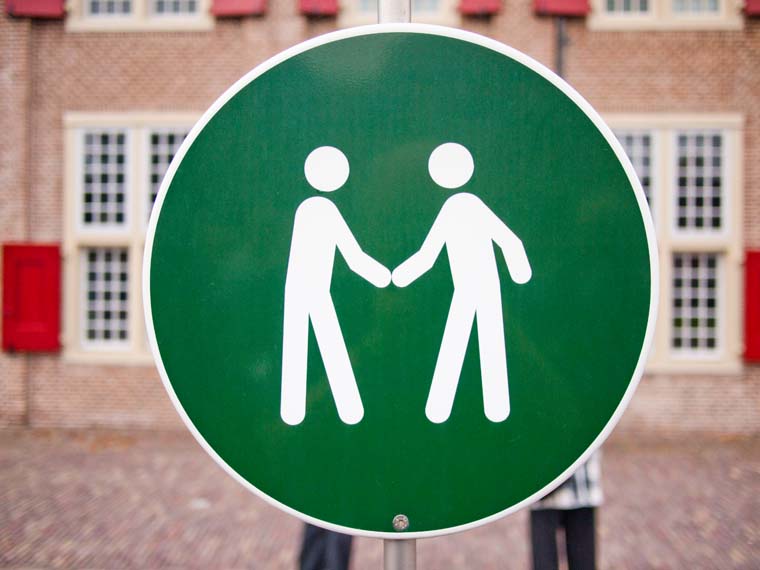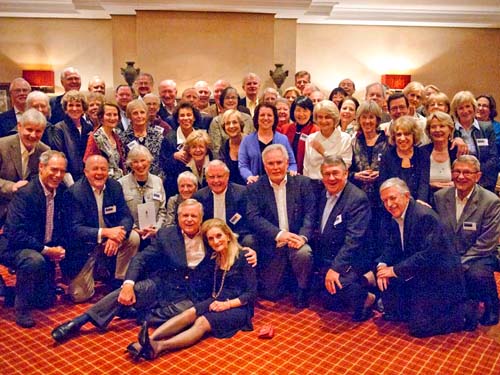 "The Netherlands You Don't Know" Now Known by 59 More!
"The Netherlands You Don't Know" Now Known by 59 More!
CAA Reunion a Social, Logistical, Educational and Culinary Success
We asked the participants in the September 23-26, 2010 CAA reunion what left the greatest impression. Some responses are below, followed by links to photo albums we could not add to the CAA Web site photo album and then a travelogue by the tour's organizer, Hans van den Houten. Next week we hope to provide a link to a video of the trip, compiled by Paul Simpson.
From Jean Marc and Marianne Bara:
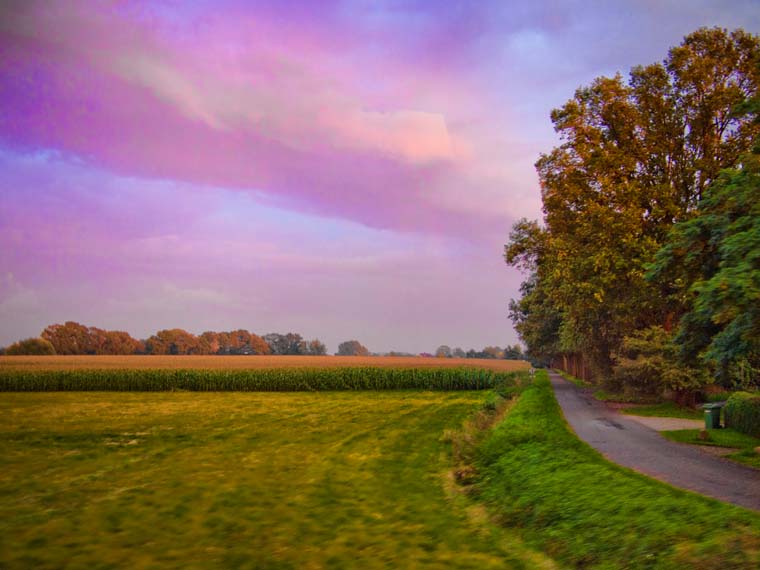 What left an impression?
What left an impression?
- those incredible painted Dutch skies are for real!
- one can find extraordinary food in the smallest corners of the Netherlands
(and did you know liquid Nitrogen can be used as a cooking aid? Do not try this at home!)
- instead of dancing shoes for Marianne’s dance lessons Jean Marc made a note to discuss clogs as an alternative.
- the toughness of the men and women who fought the battle against the seas.
- the warm hospitality of the Dutch people.
Personal highlights
- the Kröller-Müller museum collection and setting
- the magnificent dinner at the Dorset Mansion House (though all dinners were great)
- Pannenkoeken master singing an aria after lunch
- the pretty canals of Giethoorn
- the history of the people of the island of Schokland
- sunset views of the windmills at Zaanse Schans.
Hans and Marian, thanks for being wonderful hosts!
From Jim and Mary Fleming: The most interesting and informative part of the trip was to realize just how extensive the land reclamation activities have been in the Netherlands. We all know that much of Holland is actually below sea level but you don't really appreciate this until you have actually seen it in person.
The other part of note was the recreation of a Dutch landscape painting in every direction you looked on the sun drenched Sunday afternoon. It was awesome!
From Tony Singleton: The highlight for my wife and me was the special attention given my wife at the Zuiderzee museum by the ferry captain and the receptionist who convinced her to ride on the ferry (she gets seasick and does not ride in boats ). I believe that reflected the deep cultural attribute of support which we saw in the enormous work done by commmuinites to create the polder system.
And of course the superb organisation by Hans and Marian showed us the discipline of the Dutch!
From Ed Tan: Hans and Marian did a great job personalizing and customizing the Netherlands trip. It was so nice to have the trip planned by such a knowledgeable and helpful team that when we woke up Monday morning in Hotel Estherea, the Amsterdam base of the tour, I still wore my name tag to breakfast and someone in the Chase group asked me why I was still carrying name tags around as the tour was over. I thought about it and realized I was subconsciously hoping that the trip would just continue with Hans and Marian leading the charge!
Thanks also to all participants for helping celebrate my birthday Saturday night in Dutch! I will long remember this special experience.
From Maria Trinidad:
1. What left an impression? I was very impressed by the strong sense of hospitality that I experienced from the residents of Amsterdam. On more than one occasion, I was actually escorted to my destination! I have visited other European countries, and the embracing reception that I encountered in Amsterdam really stood out.
2. What was a highlight? The sense of belonging, unity and caring that I experienced with the group was very touching. Many of us have planned to meet for the November CAA event in New York City, and I very much look forward to staying in touch with my new friends. In addition, the trip was so well-organized that it offered a great deal by way of learning about the culture of the Netherlands; our visits to museums, restaurants, and hotels were very informative, with ample opportunities to ask questions.
It was a joy to exchange stories about our work experiences at Chase, and a shared bond in having so many positive memories of our careers with the Bank. And the fun that we had...there were times when we were laughing so hard that my stomach hurt.
From Tom Lynch (over Thanksgiving 2010): Certainly this Thanksgiving this Yankee [me] is very thankful that you created the Chase Alumni journey through 'the Netherlands You Don't Know' – and I will be thankful for as many Thanksgivings that come my way.
The trip was, for me, simply wonderful – and that includes my six-day, solo bike journey through the most lush and comme il faut countryside/farmland I have seen anywhere. Indeed, every house, field, animal, crop was so perfectly kept that I can only imagine those Germans over the border feel jealous and sloppy when they see it. And the air! New Yorkers are not used to fresh air like I was sniffing and breathing as I pedaled along atop dykes and along tree-canopied lanes. Yes, it did rain often; but I discovered one's clothes dry off soon enough if one keeps pedaling--especially with the wind in one's face, which it seems habitually to be in the Netherlands.
And my side trip to Utrecht was great fun. Utrecht's center made me feel like a late-medieval farmer who has wandered into a stunningly vibrant, beautiful, cosmopolitan, center of commerce, learning and music. And one of the songs had to be, "How You Goin' to Keep 'em Down on The Farm After They've Seen Utrecht."
And Amsterdam was even more so! And, I admit, switching to the comfortable back seat of that luxury bus for the last three days of my visit to the Netherlands was just that, comfortable – much easier on my bottom than the bike perch. And our two hotels were perfect. I particularly enjoyed swimming evening and morning in the Hotel de Holtweijde's perfect pool and wandering about the perfect grounds. And one tour site visited was more beautiful or fascinating or both than the previous.
In a nutshell: Thank you for so much effort and success in creating this once-in-a-lifetime chance to wander through the Netherlands You Don't Know.
Click here to see Paul Simpson's video of the trip.
Click here to see photos in Hans van den Houten's Picasa album.
Click here to see photos in Marian van den Houten's Picasa album.
Click here to see photos from Britta von Eisenhart-Rothe's Facebook album.
THE NETHERLANDS YOU DON’T KNOW
A Visit by 59 Intrepid CAA Members – September 23 - 26, 2010
by Hans van den Houten
Weeks before the start of the CAA reunion trip, my wife, Marian, and I were
already looking anxiously at the long-term weather forecast for the
Netherlands. Generally uncertain September weather could quite literally dampen
the fun we had planned in the places we’d scouted. A way of life for the Dutch
might test the spirits of visitors, but we hoped to be pleasantly surprised by
both the weather and the reactions!
We welcomed our 57 fellow travelers early in the evening on Thursday,
September 23, in the library of Hotel Estheréa in Amsterdam.
Unfortunately, at the last minute, the
Pohls could not join us from Germany, due to Kate Pohl’s having a bad case of
bronchitis.
The group appeared to like the wonderful location of the hotel, on the
Singel, one of the major city canals, and less than a five-minute walk from the
Royal Palace on the Dam Square, the heart of the city.
I ga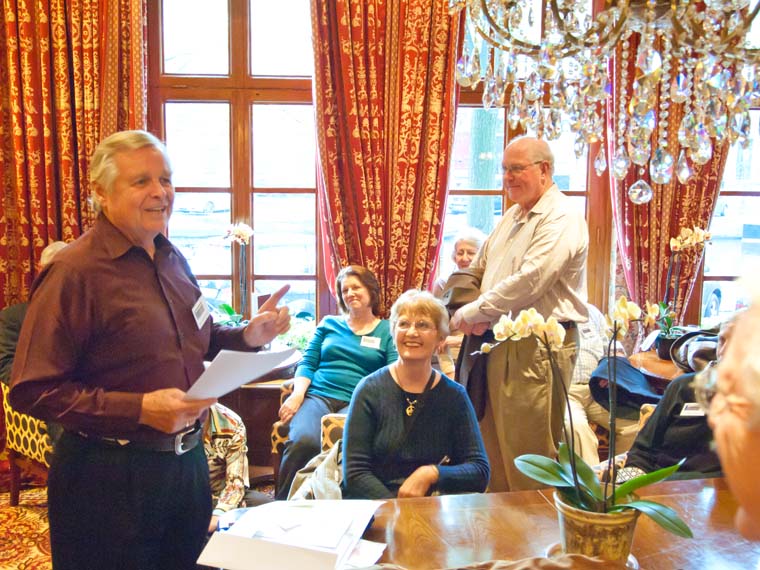 ve an introductory overview of the trip and urged the group to make
sure that they adopted the Dutch national fervor for punctuality, as it was essential
to making this trip run as smoothly as possible.
I guess I put the fear of the gods into all, as no delays
were encountered due to tardiness.
ve an introductory overview of the trip and urged the group to make
sure that they adopted the Dutch national fervor for punctuality, as it was essential
to making this trip run as smoothly as possible.
I guess I put the fear of the gods into all, as no delays
were encountered due to tardiness.
The evening started with a short walk to the
Bredero, an older model canal touring boat. We boarded with a
slight drizzle inaugurating use of the CAA-emblazoned 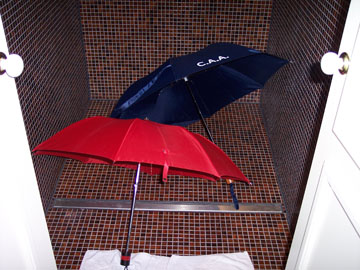 umbrellas I had ordered for
everyone. The tour through the canals was, as always, impressive, and a short,
but intense thunderstorm did not undermine the impact when, just as we started
our sail, all the lights were turned on at the many bridges across the canals.
While enjoying our libations and the snacks provided, we were captivated by the
always glorious 17th century buildings along the canals. The inner
circle of canals, the Grachtengordel, was just recently added to the list of UNESCO’s
World Heritage Sites and justly so; the ever-enchanting views of homes,
warehouses and churches bordered by tree-lined canals is a true treat to the
eye.
umbrellas I had ordered for
everyone. The tour through the canals was, as always, impressive, and a short,
but intense thunderstorm did not undermine the impact when, just as we started
our sail, all the lights were turned on at the many bridges across the canals.
While enjoying our libations and the snacks provided, we were captivated by the
always glorious 17th century buildings along the canals. The inner
circle of canals, the Grachtengordel, was just recently added to the list of UNESCO’s
World Heritage Sites and justly so; the ever-enchanting views of homes,
warehouses and churches bordered by tree-lined canals is a true treat to the
eye.
After an hour and a half of touring the canals, we debarked for the
Kantjil enTijger, one of Amsterdam’s many
Indonesian 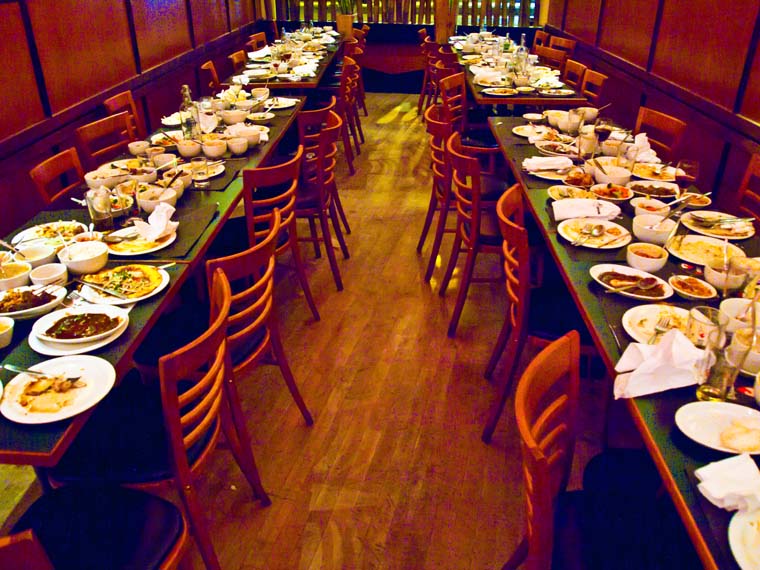 restaurants. This well
regarded restaurant put up a display of the famous Dutch Rijsttafel, a legacy of Dutch colonial days in the East Indies (now
Indonesia). Rijsttafel comprises many
dishes of delectable spiced food, heaped on the plate around a mound of rice –
and preferably downed with beer.
Our group happily complied with that tradition.
restaurants. This well
regarded restaurant put up a display of the famous Dutch Rijsttafel, a legacy of Dutch colonial days in the East Indies (now
Indonesia). Rijsttafel comprises many
dishes of delectable spiced food, heaped on the plate around a mound of rice –
and preferably downed with beer.
Our group happily complied with that tradition.
We’d planned to continue the canal tour after dinner, but a small group
returned to the hotel for a deserved rest. The remaining dozen rejoined the
Bredero and were enthralled by a now clear sky, with even a bit of moon
throwing light on the shimmering surface of the canals and the River “Het IJ”.
Friday morning, Kees, our driver from the bus company OAD, was ready at
8:15 am for the CAA group and its plentiful luggage. We boarded the luxurious bus
for our ride east to the National Park “de Hoge Veluwe” and the Kröller-Müller
Museum, which lies surrounded by the park.
The museum is a national treasure, with an exquisite
collection of art assembled by Mrs. Helen Kröller-Müller. Along with her shipping magnate
husband, she donated the 6,000 hectares of their nature reserve, as well as the
museum, to the Dutch nation.
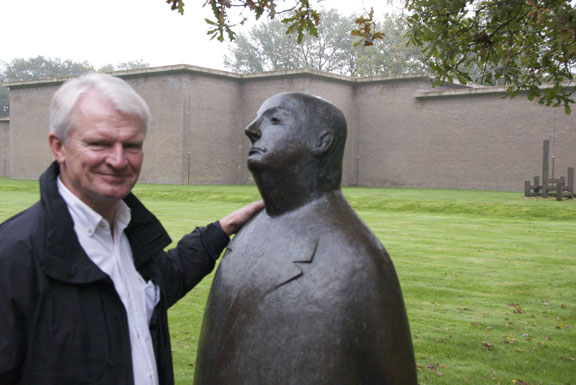 We were welcomed by the chairman of the board of the park, Frank Schreve,
and the museum director, Dr. Evert van Straaten.
After their brief introductory remarks, we started our visit,
with four guides walking us subgroups through the sculpture garden and the
museum. The collection was an eye opener to many. Mrs. Kröller-Müller with the guidance of her advisor H.P.
Bremmer, acquired almost 11,500 art objects in the early part of the 20th
century, amongst them a trove of van Gogh paintings – indeed, the largest
collection outside of the van Gogh family holdings. The two-hour visit gave an incentive to many in the group to put the
museum on an agenda for a return visit.
We were welcomed by the chairman of the board of the park, Frank Schreve,
and the museum director, Dr. Evert van Straaten.
After their brief introductory remarks, we started our visit,
with four guides walking us subgroups through the sculpture garden and the
museum. The collection was an eye opener to many. Mrs. Kröller-Müller with the guidance of her advisor H.P.
Bremmer, acquired almost 11,500 art objects in the early part of the 20th
century, amongst them a trove of van Gogh paintings – indeed, the largest
collection outside of the van Gogh family holdings. The two-hour visit gave an incentive to many in the group to put the
museum on an agenda for a return visit.
Bagged lunches were waiting on our seats as we reentered the bus, while
coffee and tea were ably served by Marian and several volunteers. Our hour-long
ride to the town of Apeldoorn and the Royal Palace, ‘t Loo, was enhanced by the
view of the lovely countryside, full of corn fields, woods and open meadows
with their omnipresent Dutch milking cows.
Paleis ‘t Loo was built as a hunting lodge for William and Mary in the
early 17
th century and last occupied by Queen Wilhelmina of the
Netherlands, who left it to the nation upon her death in 1962. It was
extensively renovated from 1976 until 1982 and opened to the public as a museum
in 1984.
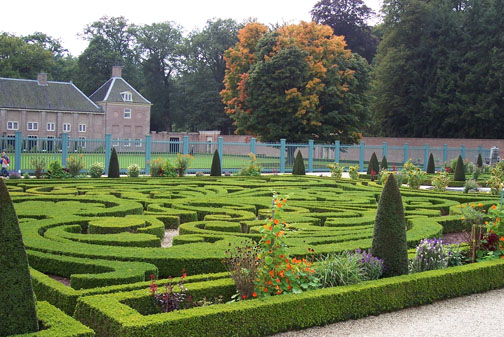
We were very fortunate, as the sun broke through the ominous clouds and
warmed our visit to Het Loo’s Baroque Dutch gardens– designed
by Claude Desgotz, who adhered to the general formula for Baroque gardens
established by his uncle André Le Nôtre in his gardens for Versailles: symmetry,
axial layout with radiating gravel walks, parterres with fountains,
basins and statues.
Our visit continued inside the palace,
where we were educated about the various Willems who reigned over the
Netherlands throughout the ages.
Onwards to our next destination in the
village of Lattrop, where we arrived after another drive through bucolic scenes
straight out of the paintings of the Dutch Masters.
Arriving at Landgoed Hotel “de Holtweijde,” one would not
know from the hotel’s simple façade that this actually was a luxurious and very
friendly place to visit. The rooms were spacious, with great views of surrounding
farmland and woods. The amenities were princely, and many of our group did not
waste much time diving into the 20-meter indoor swimming pool.
We boarded our bus after an hour of
rest, barely enough to catch one’s breath. We rode through yet more bucolic countryside
to the restaurant Dorset Mansion House in Borne.
The sunset was something to behold, with red and yellows
coloring the sky in a vivid and unexpected display of light and color,
reflecting on typically Dutch clouds.
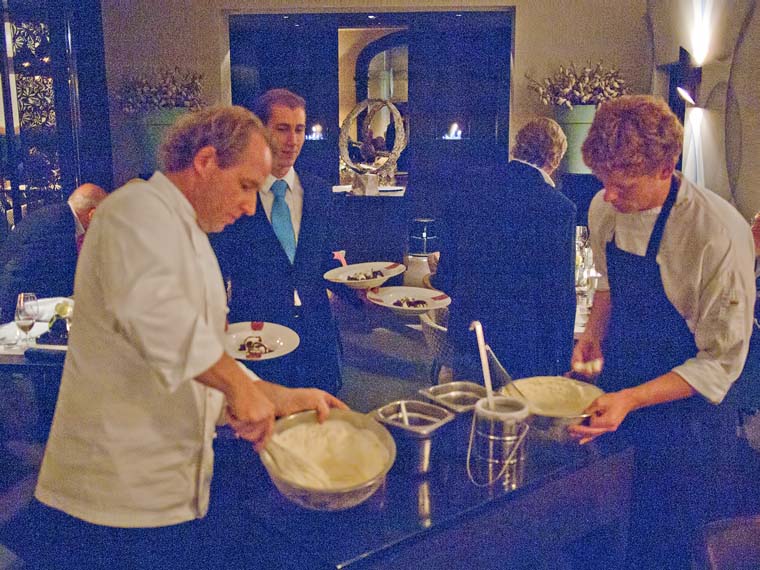
A sumptuous dinner began with an appetizer
of smoked eel and Dutch herring, both national delicacies, as well as many
other
amuses-bouche, leading to a main course of veal and
local wild mushrooms. The wines flowed happily, and the noise level increased
with the increasingly animated discussions. The dessert was also something to
behold: Willem Dankers, the executive chef, and his staff enthralled us with a
spectacular demonstration, making ice cream at our tables with nitrogen,
cooling the vanilla and cream to 196 degrees below zero, to result in a
scrumptious ice cream dessert, with other goodies to boot!
After this marvelous gastronomic
evening, we happily relaxed for the short ride back to our oasis at “De
Holtweijde”, handing out many kudos to the Dorset’s culinary acrobats.
(I might add that this restaurant held
other memories for me: It’s where Marian and I dined, after which I proposed to
her in 2005!)
We awoke Saturday, September 25, to a
beautiful day, with the sun streaming through the windows and horses happily
roaming outside in full view of several of our rooms.
After many swore never to eat again
after the prior night’s excesses, we nevertheless plunged into a hardy Dutch
breakfast.
At our n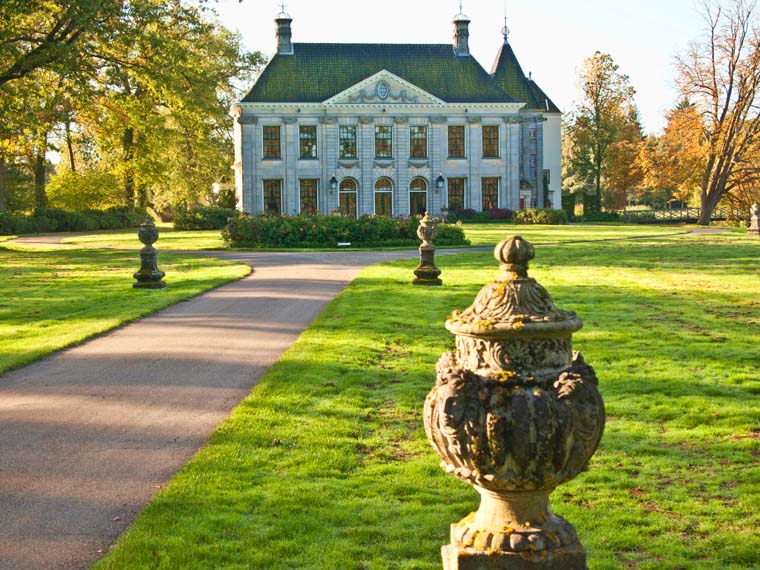 ext visit, to “Landgoed
Singraven”, half of our group was first treated to the many delights of this
country home, the other half to the watermill on the estate, before switching
sites mid-visit.
The house’s origins date to the 12th
century. After many centuries of
neglect, the house was refurbished and renovated in the early 20th
century by a wealthy Dutchman, Willem Laan. He donated the house and the estate’s
240 acres in 1960 to the Edwina van Heek Foundation.
ext visit, to “Landgoed
Singraven”, half of our group was first treated to the many delights of this
country home, the other half to the watermill on the estate, before switching
sites mid-visit.
The house’s origins date to the 12th
century. After many centuries of
neglect, the house was refurbished and renovated in the early 20th
century by a wealthy Dutchman, Willem Laan. He donated the house and the estate’s
240 acres in 1960 to the Edwina van Heek Foundation.
Edwina was an American long married
into the van Heek family, renowned for their wealth accumulated through the
textile industry, once a mainstay industry in this part of the Netherlands.
The industry fell into a massive decline
beginning around 1970. The Edwina van Heek Foundation, however, continues to
perform marvelous charitable work in the Twente region.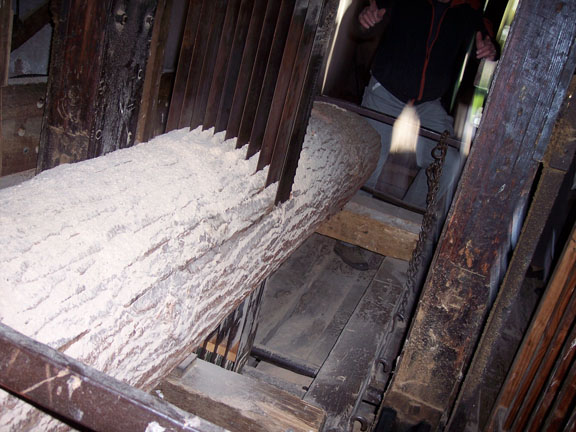
The Watermill (
de Watermolen) is a centuries-old mill still in excellent working
order, maintained and operated by one miller. He saws huge Douglas firs and other trees, such as oaks,
available on the estate. He also
mills flour, as it is a dual function mill, still driven, as it has been for centuries, by the
power of the water from the river Dinkel. After viewing this site, we were
offered coffee and tea together with a very regional treat, a slice of Krentewegge, similar to raisin bread,
but cut off of a one meter-long loaf.
Once more, after our educational
morning, we took a lovely ride through the countryside, to arrive for lunch at
Watermolen Bels, to experience another
one of those Dutch inventions, de
Pannenkoek, or pancake – but what a difference from the International House
of Pancakes! We were assisted by
the owner Maarten Bels himself to create our individualized pannenkoeken, filled with a selection of
fried eggs, bacon, cheese or vegetables. The
pannenkoek covered a dinner plate with ease, and one was ample to sustain us
travelers until our next dinner event. To thank us for coming, Bels, an amateur tenor, serenaded
us with an aria from Rigoletto, bringing us to our feet – which
made it easier to whisk us out of the cozy old barn of the Watermolen Bels and onto our bus.
Next stop: Ootmarsum, a very old town
with city rights acquired centuries ago and now a heaven of galleries and
antique stores. Its history is still very much in evidence around the old
church and the center of the town, dating back to the 13
th century.
Our guide, Jürgen, director of a local museum, displayed a great knowledge of
the historic significance of Ootmarsum and interlaced his commentary with a
number of very interesting and amusing anecdotes and sagas.
We did not have enough time to visit
the many art galleries, and some of our travelers were perhaps relieved that we
had not allocated time for spending money!
Rather, we returned to our hotel to indulge in its various amenities
offered for relaxation. Some chose to walk in the beautiful surroundings, others
used the indoor swimming pool and some just needed a snooze to revive
themsleves for dinner after a day with lots of walking.
At dinner, we were joined by another
Dutch couple, Sandor and Cécile von Balluseck, well known to other intrepid
travelers who have participated in prior CAA reunions.
Following an animated cocktail hour, we
all gathered in a separate dining room and the head chefs, Rob Fiselier and
Gerard Kooiker, demonstrated
their ample skills with a delectable display of culinary delights such as
Nobashi shrimps with smoked eel and braised young onions, followed by a poultry
bouillon, with a main course of medallion of Hereford beef surrounded by potatoes,
sugar snaps and shiitake mushrooms.
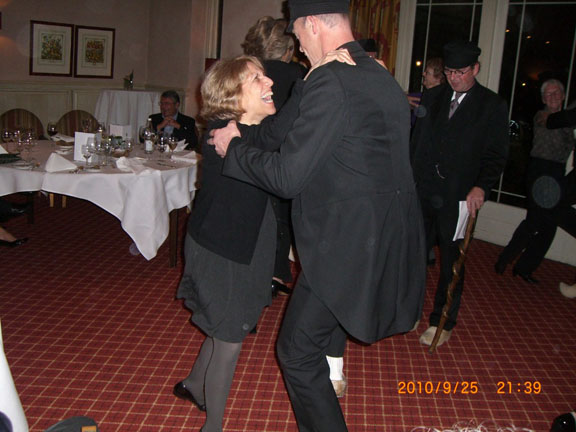 At the end of the second course, we
were surprised by the entry into the room of a group of 15 folk dancers, all
dressed in regional Twente farmer costumes, led by three accordion players. After
hearing clear explanations of the dances in English, the diners accompanied the
dancers with oohs and ahs and loud clapping. One dance required full
participation by a selection of our group, who had to get out of their chairs
and swing into action with the dancers. A great demonstration of their agility
and adaptability to all things regional followed!
At the end of the second course, we
were surprised by the entry into the room of a group of 15 folk dancers, all
dressed in regional Twente farmer costumes, led by three accordion players. After
hearing clear explanations of the dances in English, the diners accompanied the
dancers with oohs and ahs and loud clapping. One dance required full
participation by a selection of our group, who had to get out of their chairs
and swing into action with the dancers. A great demonstration of their agility
and adaptability to all things regional followed!
As if we did not have enough special
events already, Ed Tan celebrated his birthday on this day and, as a surprise,
management offered him a sparkling candle tribute and congratulatory wishes written
on his dessert plate. I was similarly honored, although my 70th birthday
had already been celebrated in August. Thanks to all for remembering, as the
organization of this event was part birthday gift to myself!
S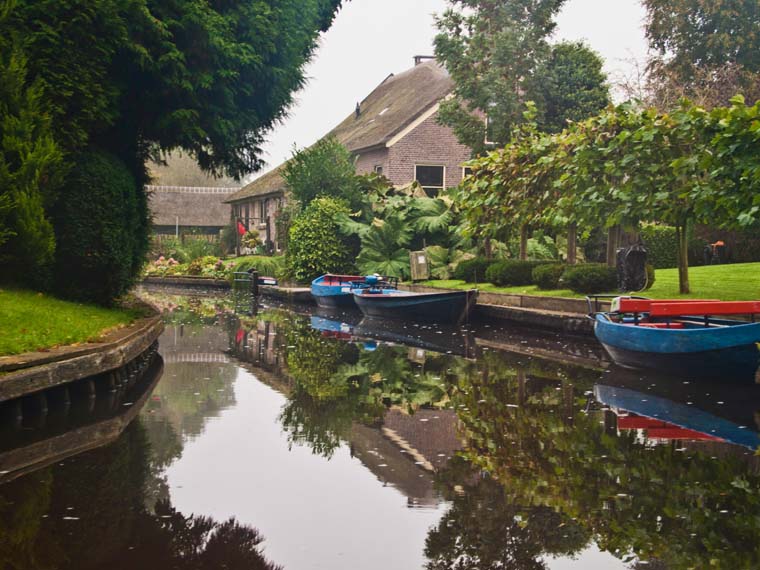 unday, September 26, our last day of a
hectic, but very rewarding and enchanting trip, started early again and brought
us to the village of Giethoorn, located in the midst of a watery environment of
canals, ditches and lakes. Unfortunately, a dense fog shrouded the early part
of the morning – fog, alas, being a part of the Netherlands many of us
do know! Much of the lovely countryside was invisible, but not so a
great flock of storks, perched on the street lights on the way to our
destination, proof of the extensive efforts of the Dutch to revive the stork population
and get storks to resettle in this region.
unday, September 26, our last day of a
hectic, but very rewarding and enchanting trip, started early again and brought
us to the village of Giethoorn, located in the midst of a watery environment of
canals, ditches and lakes. Unfortunately, a dense fog shrouded the early part
of the morning – fog, alas, being a part of the Netherlands many of us
do know! Much of the lovely countryside was invisible, but not so a
great flock of storks, perched on the street lights on the way to our
destination, proof of the extensive efforts of the Dutch to revive the stork population
and get storks to resettle in this region.
We visited Giethoorn by boat, as there
are no roads, just paths for walking, or bicycle riding. All goods have to be
hauled around town on barges. Public and private transportation is by whisper
boats, running on electricity, or by a variety of other boats powered by low
horsepower motors. Giethoorn is often called the Venice of the North, though it
is only its canals and waterways that offer the comparison to the real Venice; Giethoorn
is much smaller, with many restored farms rather than opulent buildings.
This former provider of vast amounts of
peat, though, is undoubtedly recognized as a travel destination, for one
million visitors manage to find their way annually to enjoy its idyllic charms,
thatch-roofed farmhouses and high-level arched bridges.
Onwards we traveled to the former
island of Schokland, now also a UNESCO-designated World Heritage Site. This was
an opportunity to learn a great deal about the
polders in the Netherlands and land reclaimed from the former
Zuiderzee, now called Ysselmeer. The island is still elevated about five meters
above sea level and surrounded by farmland, which was formerly the bottom of
the sea. We learned about the devastating storms, which dissected the island in
the 19th century, leading to the subsequent evacuation of the island
by the Dutch government in 1859.
We also learned about the “Schokland
Dance”: When the Schokkers ran into each other from
opposite directions on the narrow foot planks between the villages, they had to
grab each other by the waist and make a half turn around in order to pass one
another. If they ran into a nice young girl along the way, they would tend to
make a few extra turns; legend has it that many
a marriage was started on the plank! We saw the dance demonstrated in a very informative movie
about the plight of the island in the past.
Although, we could have stayed much
longer with our excellent guides, one more stop had to be made to add to our
knowledge about the unknown Netherlands, particularly about the way people
lived in the past in small, but charming homes, often deprived of proper
heating, dependent on the sea to provide for food on their tables. So we drove
23 kilometers to the town of Enkhuizen to visit the Zuiderzee Museum, enjoying
another white “Brown bag” lunch with great Dutch buns – all the while riding on
top of a dike that withheld the waters of the Ysselmeer from flooding into the
lower lying waters of the Markerwaard.
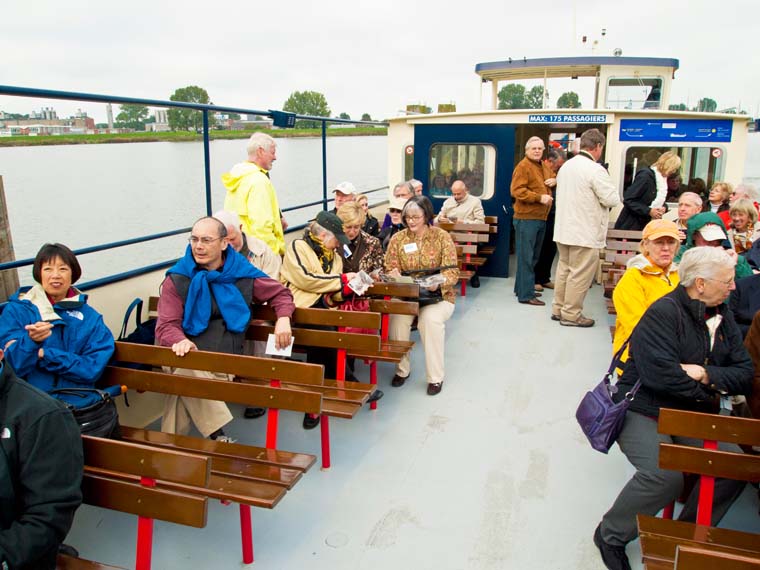
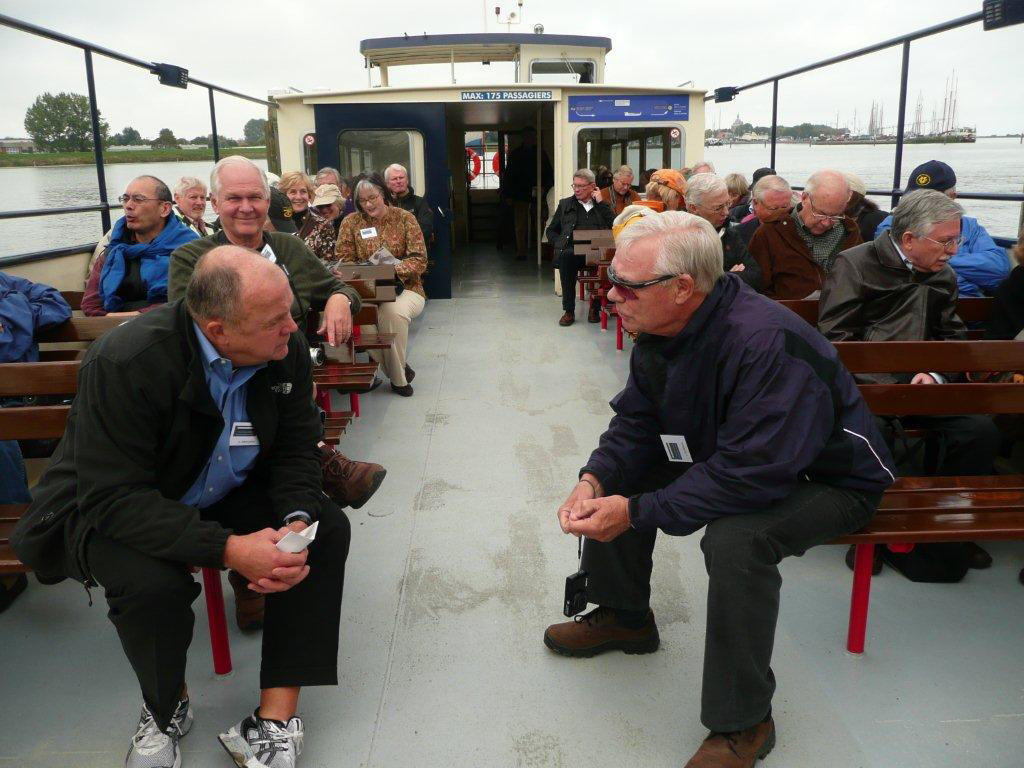
One must switch to a ferry to reach the
Zuiderzee Museum, and Sherry Singleton, who was not made out to be a sailor, initially
refused to sail with the small ferry to the museum. She was escorted by two Dutch boatmen to the museum, who convinced
her that sailing was something she could easily endure on the now calm waters
of the Ysselmeer! Hurrah for Sherry, and thanks to our Dutch sailors for their
kindness and support!
The final visit to the museum was
certainly enhanced by the expert commentary of our guides. We saw a still
working watermill and the process of draining water from the polder to a
holding reservoir and onwards, through a sluice, to the sea. We witnessed the smoking of eel and the preparing of a herring product
called
bokking. Much was learned about how a network of dikes extending 17,500 kilometers, protecting
a large percent of Dutch from the ever encroaching waters of the surrounding
North Sea. As the saying goes, “God created the world, but the Dutch created
the Netherlands!” This too was too
short a visit, and once again a major incentive to the group to think about
planning a return visit.
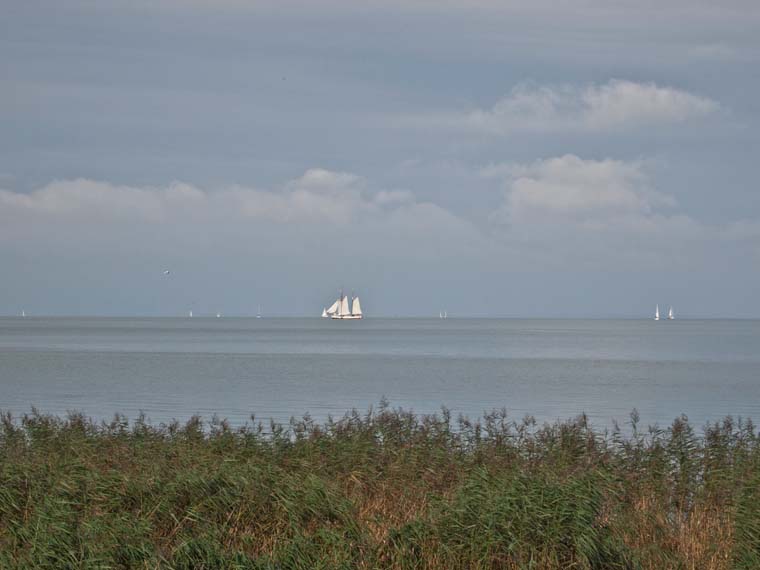 A final boat ride back to the bus was a
true treat, as the sun basked upon us on the ferry deck.
We sailed to the town of Enkhuizen with
its multiple pleasure boat harbors, encountering flat bottom boats with city
folks returning from their Sunday outings.
A final boat ride back to the bus was a
true treat, as the sun basked upon us on the ferry deck.
We sailed to the town of Enkhuizen with
its multiple pleasure boat harbors, encountering flat bottom boats with city
folks returning from their Sunday outings.
As if this trip would never end, we
took another ride through and past much “polderland” and specifically the area
called de Beemster. This is the
oldest polder in the Netherlands, dried during the period from 1609 through
1612. Since 1999, de Beemster is a UNESCO
World Heritage Site. Aside from offering a timeless view of orderly canals and
green pastures, the area is known for its famous Beemster cheese. We were
treated to a variety of views reminiscent of the great paintings of the Dutch
landscape painters of the 17th century – proof that this their paintings
were not just figments of their imagination, but real and realistic portrayals
of the polder landscape north of Amsterdam.
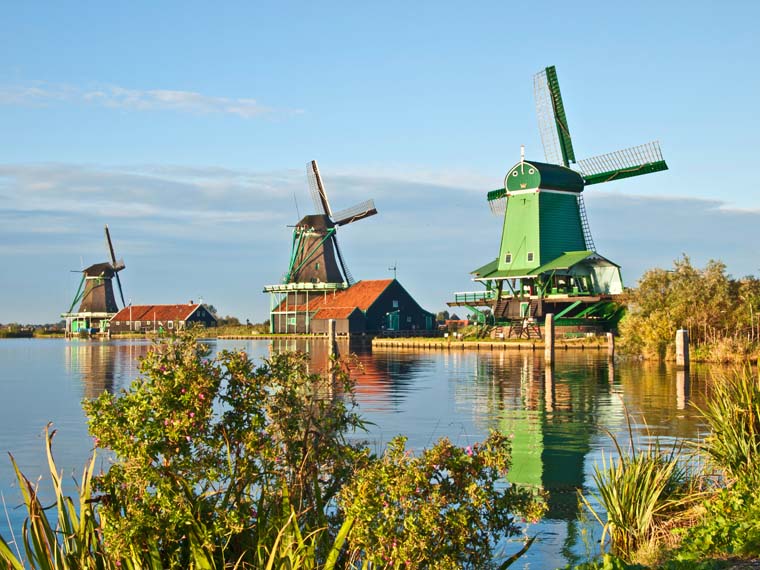
Arriving at the Zaanse Schans, a living
history village, just after the close of local
museum activities, we were still able to see many windmills,
brought to this place to form a living example of the different uses for these
mills. The windmills are constructed in a style typical for the region, as are about
35 houses from all over the Zaanstreek,
relocated here during the 1970s. The “Zaanstreek” was famous for its
shipbuilding activities. Indeed, Czar Peter the Great spent four months in this
region in 1697 to learn shipbuilding techniques.
A short walk through the village
brought us to our final destination, to enjoy dinner at Restaurant “de Hoop op
d’Swarte Walvis”, a well-known gastronomic retreat on the river de Zaan. The
weather favored us and allowed us to enjoy cocktails in the outdoor garden
bordering the river, providing a great view of some of the typical Zaanse
houses across the waters.
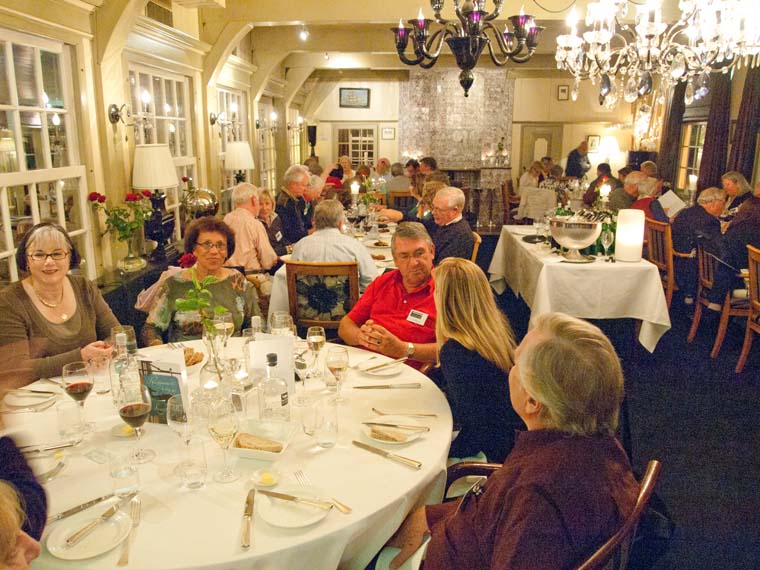
Ours was a typical Zaans-style
restaurant, with wooden beams and big chandeliers and tables for eight. We began
with homemade paté de campagne, followed by a delicious clear bouillon with
mushrooms and sautéed pike-perch. Since hunting season had opened, the main
course featured wild duck, sautéed whole with all the right trimmings. A final
delectable dessert was the crown on three nights of indulgence. Of course, all
the appropriate wines were served with the food, the libations adding to a really
animated evening.
Marian and I appreciated the kind words
from CAA President John Ward about our work
organizing the trip, as well as the knowledge that a check would
be donated in our name to the High Desert Museum in Bend, Oregon, where we make
our residence part of the year.
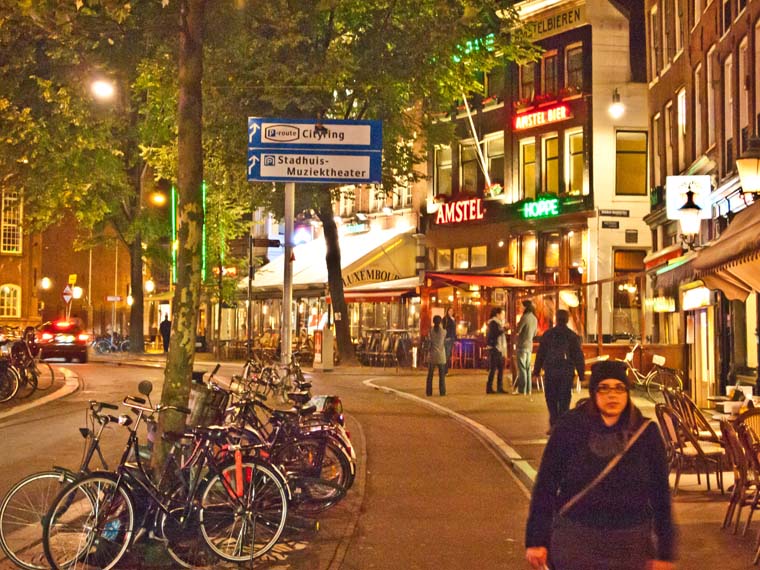
We returned safely to the Hotel
Estheréa on the Singel in Amsterdam. Over three days, we covered a great number
of miles in a very small country that unfolded to us a remarkable landscape
both in variety as in different weather conditions. We were able to strengthen
existing friendships and found communality of thought and rewards due to our
membership of the Chase Alumni Association.
Now onwards to the next event – perhaps
even back to the Netherlands, for yet more areas of
The Netherlands You Don’t Know!
– Photos by Jean Marc Bara, Jean Claude Schaeffer, John Locher, Tony Singleton, Tom Lynch and others. To see more photos, visit the online photo album.
